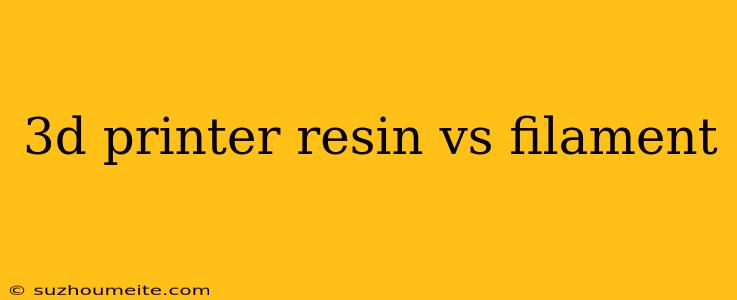3D Printer Resin vs Filament: Which One Reigns Supreme?
The world of 3D printing has undergone significant transformations in recent years, with multiple technologies and materials emerging to cater to diverse needs and preferences. Two popular options stand out among the rest: 3D printer resin and filament. Both have their advantages and disadvantages, and choosing the right one can be a daunting task. In this article, we'll delve into the details of 3D printer resin vs filament, exploring their characteristics, benefits, and drawbacks to help you make an informed decision.
What is 3D Printer Resin?
3D printer resin is a type of photopolymer that hardens when exposed to light. It's a liquid material that's typically used in Stereolithography (SLA) and Digital Light Processing (DLP) 3D printing technologies. Resin is ideal for creating highly detailed and accurate models with smooth surfaces.
Advantages of 3D Printer Resin:
- High accuracy and detail: Resin produces prints with exceptional accuracy and detail, making it perfect for prototyping, jewelry making, and dental applications.
- Smooth surfaces: Resin prints have a smooth, glossy finish that requires minimal post-processing.
- Low layer thickness: Resin can achieve layer thicknesses as low as 0.01mm, resulting in highly detailed prints.
Disadvantages of 3D Printer Resin:
- Expensive equipment: SLA and DLP printers are generally more expensive than FFF/FDM printers.
- Post-curing required: Resin prints require a post-curing process to achieve optimal strength and durability.
- Limited material options: Resin options are limited compared to filament materials.
What is 3D Printer Filament?
3D printer filament is a type of thermoplastic material that's melted and extruded through a heated nozzle to create a 3D object. Filament is commonly used in FFF/FDM (Fused Filament Fabrication) 3D printing technology. Filament is available in various materials, including PLA, ABS, PETG, and more.
Advantages of 3D Printer Filament:
- Cost-effective: Filament is generally cheaper than resin, and FFF/FDM printers are more affordable than SLA/DLP printers.
- Wide material options: Filament is available in a wide range of materials, each with unique properties and applications.
- Easy to use: FFF/FDM printers are relatively easy to operate and maintain.
Disadvantages of 3D Printer Filament:
- Lower accuracy and detail: Filament prints may not achieve the same level of accuracy and detail as resin prints.
- Layer lines and texture: Filament prints often exhibit visible layer lines and texture, which may require post-processing.
3D Printer Resin vs Filament: The Verdict
When deciding between 3D printer resin and filament, consider the following:
- Accuracy and detail: If you need highly detailed prints with smooth surfaces, resin might be the better choice.
- Cost and accessibility: If you're on a budget and prefer a more affordable option with a wider range of material options, filament might be the way to go.
- Post-processing and maintenance: If you're willing to invest time in post-processing and maintaining your printer, resin could be the better option.
Ultimately, the choice between 3D printer resin and filament depends on your specific needs, preferences, and printing goals. By understanding the advantages and disadvantages of each, you can make an informed decision and unlock the full potential of your 3D printing projects.
